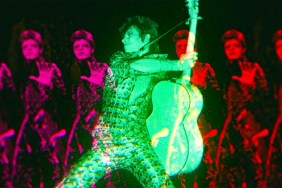
SHOCK reviews David Bowie’s surreal live stage re-imagining of THE MAN WHO FELL TO EARTH.
David Bowie is the ultimate outsider, and his spotlight role as Thomas Jerome Newton, in Nicolas Roegs THE MAN WHO FELL TO EARTH, is a defining lifetime moment in the artists career. Every image surrounding the film, from the alien profile featured on both poster and the “Low” album cover, to all the cuts and trims the film was subjected to over the years, just screams Bowie. And that film’s final frame of Newtons head bowed, with a glass of gin in front of him, his hat hiding his face, is where LAZARUS picks up.
DEXTER’s Michael C. Hall, fresh from wowing the crowds on Broadway with his take on John Cameron Mitchells HEDWIG, lies flat on the stage, covered with a sheet as the audience takes their seats. As the lights dim the theater changes from a blank space to a big box of Bowie. A central large screen flickers with rapid-fire images, re-imagining the bank of televisions in Roegs film onto a single electronic canvas, presented as a low-res airwaves-intercept experience. Its pretty obvious from this get-go that Lazarus isnt your regular musical, but more of an experience, and when Mr. Hall cuts into the brilliance inner-cry of Bowies Its No Game (Pt. 1), off the artists seminal “Scary Monsters (and Super Creeps)” album, complete with Lynn Craig as a geisha re-birthing images from the film, were definitely going into less-traveled territory…
And thats where LAZARUS fully succeeds. This is a Bowie show. LAZARUS takes pieces from Bowies music, album covers (a few of which lay propped up on the right of the stage next to a turntable), music videos, and more, to belie a virtual scrapbook of the artists career and ideas new, used, and unused. Hall as Newton yanking curtains from the back of the stage that cover the musicians playing the shows score live, revisits Bowies music video for D.J. while the whole show couldve easily been titled Breaking Glass, a track off Bowies accompanying-the-original-film album “Low”.

And this is where the pixie-ish self-destructiveness of Cristin Miliotis character Elly really lets fly. Although that lovely refrain of Baby, Ive been, breaking glass in your room again is left out of the show, the actions of the cast are everything that song represents. You can almost just feel the mayhem that will erupt out of that bright-white-light refrigerator as the show opens. I hope Miliotis chiropractor is on daily standby as she contorts her body throughout and hobbles around in off-balance high heels, and blue wig to match.
And again in this mish-mash of a Bowie wonderland characters come in and out, fleeting glimpses of others appear on screen (Im still not sure what Alan Cumming was doing up there), and Michael Esper makes his Valentine a sinister character with a little softshoe, all contributing the flow and feel of peak Bowie from Ashes to Ashes through his ineffable 1979 appearance on Saturday Night Live, where instead of publicizing new songs he appeared in a Hugo Ballesque outfit emoting The Man Who Sold the World (which is also sung in Lazarus), before jumping into a grayish schoolmarm dress for TVC15 (another song that would fit perfect in Lazarus), before ending with his head mounted on a silly-putty-like Tarzan body for Boys Keep Swinging. If just this one sentence intrigues you, youre ready to try for one of the sold-out seats for LAZARUS.
The New York Theater Workshop is a great space for a show like LAZARUS. Directly across the street from famed LaMaMa, the performance-art home of the late Tom Murrin, Dancenoises Lucy Sexton and Anne Iobst, and Steve Buscemi, the music-video/performance art/video art choreography of Lazarus, with nods to so many of Bowies previous persona, all of which influenced many an East Villager, are perfectly at home in this space. And much like Newton, a creation of Bowie at his most drug-addled (he states he remembers nothing of the films production), the geishas and black balloons and milky secretions (a distinct reference to more oddities in the film) of Lazarus are manifestations of the loneliness, solitude, and distance that the icy tendrils of alienation forces onto an individual. Pained, unable to connect, and with a masking-tape spaceship as the getaway vehicle from ones self, and highlighted by eighteen songs both classic and new, Lazarus is a choice extension in the grand oeuvre for the perpetually enigmatic and highly individual artistry of David Bowie.
LAZARUS is sold out for its entire run through Jan. 20, though occasional tickets are popping up through the New York Theater Workshop’s website.
http://www.dailymotion.com/video/x2ll256









